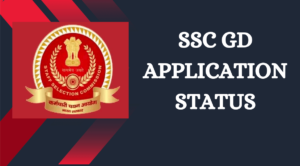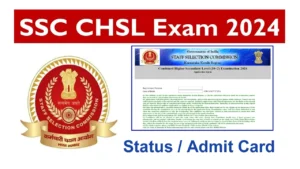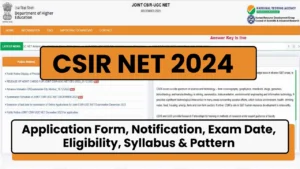The Staff Selection Commission invited the application for the SSC CGL Examination 2024. Candidates can apply online for the vacancy between the given time frame, 24 June 2024 to 24 July 2024. Speculations are coming that the exam will be conducted in September or October. Along with the syllabus the authority also released the SSC CGL Syllabus 2024 for Tier One and Two. Questions will come from subjects like Mathematics, English, General Awareness and Reasoning in the SSC CGL Exam. Moreover, the notification PDF will be available on the official website of SSC from 24 June 2024 at ssc.gov.in. It is very important for candidates to go through the notification PDF to fill out the exam form properly. And also if they want to clear this exam they must learn the syllabus and keep it on their tips. Here we have included the SSC CGL Syllabus and Exam Pattern in this article.
SSC CGL Tier-I Syllabus
SSC CGL Tier-I Syllabus: Quantitative Aptitude
| Topic |
|---|
| Computation of whole numbers |
| Decimals |
| Fractions |
| Relationships between numbers |
| Profit and Loss |
| Discount |
| Partnership Business |
| Mixture and Alligation |
| Time and distance |
| Time & Work |
| Percentage |
| Ratio & Proportion |
| Square roots |
| Averages |
| Interest |
| Basic algebraic identities of School Algebra & Elementary surds |
| Graphs of Linear Equations |
| Triangle and its various kinds of centres |
| Congruence and similarity of triangles |
| Circle and its chords, tangents, angles subtended by chords of a circle, common tangents to two or more circles |
| Triangle |
| Quadrilaterals |
| Regular Polygons |
| Right Prism |
| Right Circular Cone |
| Right Circular Cylinder |
| Sphere |
| Heights and Distances |
| Histogram |
| Frequency polygon |
| Bar diagram & Pie chart |
| Hemispheres |
| Rectangular Parallelepiped |
| Regular Right Pyramid with triangular or square base |
| Trigonometric ratio |
| Degree and Radian Measures |
| Standard Identities |
| Complementary angles |
SSC CGL Tier-I Syllabus: General Intelligence and Reasoning
| Topic |
|---|
| Analogies |
| Similarities and differences |
| Space visualization |
| Spatial orientation |
| Problem-solving |
| Analysis |
| Judgment |
| Blood Relations |
| Decision making |
| Visual memory |
| Discrimination |
| Observation |
| Relationship concepts |
| Arithmetical reasoning |
| Figural classification |
| Arithmetic number series |
| Non-verbal series |
| Coding and decoding |
| Statement conclusion |
| Syllogistic reasoning |
SSC CGL Tier-I Syllabus: English Language
| Topic |
|---|
| Idioms and Phrases |
| One word Substitution |
| Sentence Correction |
| Error Spotting |
| Fill in the Blanks |
| Spellings Correction |
| Reading Comprehension |
| Synonyms-Antonyms |
| Active Passive |
| Sentence Rearrangement |
| Sentence Improvement |
| Cloze test |
SSC CGL Tier-I Syllabus: General Awareness
| Topic |
|---|
| India and its neighbouring countries especially pertaining to History, Culture, Geography, Economic Scene, General Policy & Scientific Research |
| Science |
| Current Affairs |
| Books and Authors |
| Sports |
| Important Schemes |
| Important Days |
| Portfolio |
| People in News |
| Static GK |
SSC CGL Syllabus 2024 for Tier 2
Module-I of Session-I of Paper-I (Mathematical Abilities)
| Topics | Sub-topics |
|---|---|
| Number Systems | Computation of Whole Number, Decimal and Fractions, Relationship between numbers |
| Fundamental Arithmetical Operations | Percentages, Ratio and Proportion, Square roots, Averages, Interest (Simple and Compound), Profit and Loss, Discount, Partnership Business, Mixture and Alligation, Time and distance, Time and work |
| Algebra | Basic algebraic identities of School Algebra and Elementary surds (simple problems), Graphs of Linear Equations |
| Geometry | Similarity with elementary geometric figures and facts: Triangle and its various kinds of centres, Congruence and similarity of triangles, Circle and its chords, tangents, angles subtended by chords of a circle, common tangents to two or more circles |
| Mensuration | Triangle, Quadrilaterals, Regular Polygons, Circle, Right Prism, Right Circular Cone, Right Circular Cylinder, Sphere, Hemispheres, Rectangular Parallelepiped, Regular Right Pyramid with triangular or square base |
| Trigonometry | Trigonometric ratios, Complementary angles, Height and distances (simple problems only), Standard Identities |
| Statistics and Probability | Use of Tables and Graphs: Histogram, Frequency polygon, Bar-diagram, Pie-chart, Measures of central tendency: mean, median, mode, standard deviation, Calculation of simple probabilities |
Module-II of Section-I of Paper-I (Reasoning and General Intelligence)
| Topics | Sub-topics |
|---|---|
| Reasoning and General Intelligence | Semantic Analogy, Symbolic operations, Symbolic/ Number Analogy, Trends, Figural Analogy, Space Orientation, Semantic Classification, Venn Diagrams, Symbolic/ Number Classification, Drawing inferences, Figural Classification, Punched hole/ pattern-folding & unfolding, Semantic Series, Figural Pattern folding and completion, Number Series, Embedded figures, Figural Series, Critical Thinking, Problem-Solving, Emotional Intelligence, Word Building, Social Intelligence, Coding and de-coding, Numerical operations, Other sub-topics, if any |
Module-I of Section-II of Paper-I (English Language and Comprehension)
| Topics | Sub-topics |
|---|---|
| English Language and Comprehension | Vocabulary, English Grammar, Sentence structure, Spot the Error, Fill in the Blanks, Synonyms/Homonyms, Antonyms, Spellings/ Detecting misspelt words, Idioms & Phrases, One word substitution, Improvement of Sentences, Active/ Passive Voice of Verbs, Conversion into Direct/ Indirect narration, Shuffling of Sentence parts, Shuffling of Sentences in a passage, Cloze Passage, Comprehension Passage – To test comprehension, three or more paragraphs will be given and questions based on those will be asked. At least one paragraph should be a simple one based on a book or a story and the other two paragraphs should be on current affairs, based on a report or an editorial |
Module-II of Section-II of Paper-I (General Awareness)
| Topics | Sub-topics |
|---|---|
| General Awareness | India and its neighbouring countries especially pertaining to History, Culture, Geography, Economic Scene, General Policy & Scientific Research, Science, Current Affairs, Books and Authors, Sports, Important Schemes, Important Days & Dates, Portfolio, People in News |
SSC CGL Tier 1 Exam Pattern 2024
| SNo. | Sections | No. of Questions | Total Marks | Time Allotted |
|---|---|---|---|---|
| 1 | General Intelligence and Reasoning | 25 | 50 | A cumulative time of 60 minutes (1 hour) |
| 2 | General Awareness | 25 | 50 | |
| 3 | Quantitative Aptitude | 25 | 50 | |
| 4 | English Comprehension | 25 | 50 | |
| Total | – | 100 | 200 | 60 minutes (1 hour) |
SSC CGL Tier 2 Exam Pattern 2024
SSC CGL Tier 2 Paper 1 Exam Pattern
| Sections | Module | Subject | No. of Questions | Marks | Weightage |
|---|---|---|---|---|---|
| Section I | Module I | Mathematical Abilities | 30 | 60*3 = 180 | 23% |
| Module II | Reasoning and General Intelligence | 30 | 60*3 = 180 | 23% | |
| Section II | Module I | English Language and Comprehension | 45 | 70*3 = 210 | 35% |
| Module II | General Awareness | 25 | 25*3 = 75 | 19% | |
| Section III | Module I | Computer Knowledge Test | 20 | 20*3 = 60 | Qualifying |
| Module II | Data Entry Speed Test | One Data Entry Task | Qualifying | Qualifying |
SSC CGL Tier 2 Paper 2 & 3 Exam Pattern
| Paper | Section | No. of Questions | Maximum Marks | Duration |
|---|---|---|---|---|
| Paper II | Statistics | 100 | 200 | 2 hours |
| Paper III | General Studies (Finance and Economics) | 100 | 200 | 2 hours |
Module-I of Section-III of Paper-I (Computer Proficiency)
| Topics | Sub-Topics |
|---|---|
| Computer Basics | Organization of a computer, Central Processing Unit (CPU), Input/ output devices, Computer memory, Memory organization, Back-up devices, PORTs, Windows Explorer, Keyboard shortcuts |
| Software | Windows Operating system including basics of Microsoft Office like MS word, MS Excel and Power Point etc. |
| Working with the Internet and e-mails | Web Browsing & Searching, Downloading & Uploading, Managing an E-mail Account, e-Banking |
| Basics of networking and cyber security | Networking devices and protocols, Network and information security threats (like hacking, virus, worms, Trojan etc.) and preventive measures |
SSC CGL Tier 2 Syllabus – Paper 2 (Statistics)
| Subject | Topics |
|---|---|
| 1. Collection, Classification and Presentation of Statistical Data | Primary and Secondary data, Methods of data collection; Tabulation of data; Graphs and charts; Frequency distributions; Diagrammatic presentation of frequency distributions. |
| 2. Measures of Central Tendency | Common measures of central tendency – mean median and mode; Partition values- quartiles, deciles, percentiles. |
| 3. Measures of Dispersion | Common measures of Dispersion – range, quartile deviations, mean deviation and standard deviation; Measures of relative dispersion. |
| 4. Moments, Skewness and Kurtosis | Different types of moments and their relationship; the meaning of skewness and kurtosis; different measures of skewness and kurtosis. |
| 5. Correlation and Regression | Scatter diagram; simple correlation coefficient; simple regression lines; Spearman’s rank correlation; Measures of association of attributes; Multiple regression; Multiple and partial correlation (For three variables only). |
| 6. Probability Theory | Meaning of probability; Different definitions of probability; Conditional probability; Compound probability; Independent events; Bayes’ theorem. |
| 7. Random Variable and Probability Distributions | Random variable; Probability functions; Expectation and Variance of a random variable; Higher moments of a random variable; Binomial, Poisson, Normal and Exponential distributions; Joint distribution of two random variables (discrete). |
| 8. Sampling Theory | Concept of population and sample; Parameter and statistic, Sampling and non-sampling errors; Probability and non-probability sampling techniques (simple random sampling, stratified sampling, multistage sampling, multiphase sampling, cluster sampling, systematic sampling, purposive sampling, convenience sampling and quota sampling); Sampling distribution (statement only); Sample size decisions. |
| 9. Statistical Inference | Point estimation and interval estimation, Properties of a good estimator, Methods of estimation (Moments method, Maximum likelihood method, Least squares method), Testing of hypothesis, Basic concept of testing, Small sample and large sample tests, Tests based on Z, t, Chi-square and F statistic, Confidence intervals. |
| 10. Analysis of Variance | Analysis of one-way classified data and two-way classified data. |
| 11. Time Series Analysis | Components of time series, Determination of trend component by different methods, Measurement of seasonal variation by different methods. |
| 12. Index Numbers | Meaning of Index Numbers, Problems in the construction of index numbers, Types of index number, Different formulae, Base shifting and splicing of index numbers, Cost of living Index Numbers, Uses of Index Numbers. |
SSC CGL Tier 2 Syllabus – Paper 3 (General Studies-Finance and Economics)
| Part | Subject | Topics |
|---|---|---|
| Part A: Finance and Accounts (80 marks) | Financial Accounting | Nature and scope, Limitations of Financial Accounting, Basic concepts and Conventions, Generally Accepted Accounting Principles |
| Part A: Finance and Accounts (80 marks) | Basic concepts of accounting | Single and double entry, Books of Original Entry, Bank Reconciliation, Journal, ledgers, Trial Balance, Rectification of Errors, Manufacturing, Trading, Profit & Loss Appropriation Accounts, Balance Sheet, Distinction between Capital and Revenue Expenditure, Depreciation Accounting, Valuation of Inventories, Non-profit organisations Accounts, Receipts and Payments and Income & Expenditure Accounts, Bills of Exchange, Self Balancing Ledgers |
| Part B: Economics and Governance (120 marks) | Comptroller & Auditor General of India | Constitutional provisions, Role and responsibility |
| Part B: Economics and Governance (120 marks) | Finance Commission | Role and functions |
| Part B: Economics and Governance (120 marks) | Basic Concept of Economics and introduction to Micro Economics | Definition, Scope and nature of Economics, Methods of economic study, Central problems of an economy, Production possibilities curve |
| Part B: Economics and Governance (120 marks) | Theory of Demand and Supply | Meaning and determinants of demand, Law of demand and Elasticity of demand, Price, Income and cross elasticity, Theory of consumer’s behaviour, Marshallian approach and Indifference curve approach, Meaning and determinants of supply, Law of supply, The elasticity of Supply |
| Part B: Economics and Governance (120 marks) | Theory of Production and cost | Meaning and Factors of production, Laws of production- Law of variable proportions and Laws of returns to scale. |
| Part B: Economics and Governance (120 marks) | Forms of Market and price determination in different markets | Various forms of markets – Perfect Competition, Monopoly, Monopolistic Competition, Oligopoly, Price determination in these markets. |
| Part B: Economics and Governance (120 marks) | Indian Economy | Nature of the Indian Economy, Role of different sectors, Role of Agriculture, Industry and Services – their problems and growth. |
| Part B: Economics and Governance (120 marks) | National Income of India | Concepts of national income, Different methods of measuring national income. |
| Part B: Economics and Governance (120 marks) | Population | Its size, rate of growth and its implication on economic growth. |
| Part B: Economics and Governance (120 marks) | Poverty and unemployment | Absolute and relative poverty, types, causes and incidence of unemployment. |
| Part B: Economics and Governance (120 marks) | Infrastructure | Energy, Transportation, Communication. |
| Part B: Economics and Governance (120 marks) | Economic Reforms in India | Economic reforms since 1991, Liberalisation, Privatisation, Globalisation, Disinvestment |
| Part B: Economics and Governance (120 marks) | Money and Banking | Monetary/ Fiscal policy – Role and functions of Reserve Bank of India; functions of commercial Banks/RRB/Payment Banks. |
| Part B: Economics and Governance (120 marks) | Budget and Fiscal deficits | Balance of payments, Fiscal Responsibility and Budget Management Act, 2003. |
| Part B: Economics and Governance (120 marks) | Role of Information Technology in Governance |




